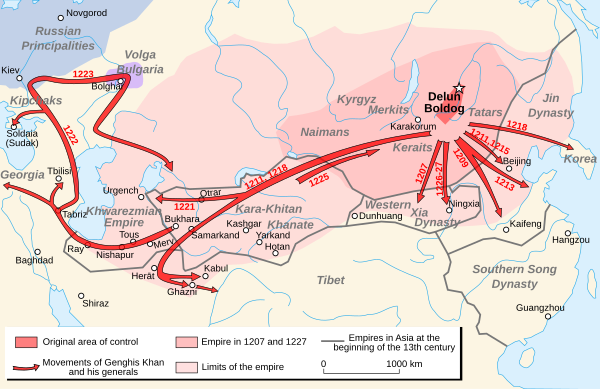Mongol invasion of Europe
| Mongol invasion of Europe | |||||||||
|---|---|---|---|---|---|---|---|---|---|
| Part of the Mongol invasions and conquests | |||||||||
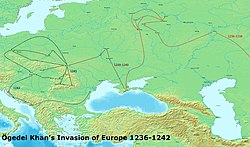 Mongol invasion of Europe 1236–1242 | |||||||||
| |||||||||
| Belligerents | |||||||||
Kingdom of Poland
Supported by:
| Mongol Empire | ||||||||
From the 1220s into the 1240s, the
General overview
Invasions and conquest of Kievan Rus'
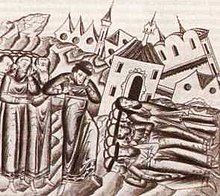

In 1223, Mongols routed a near 50,000 Rus'/Cuman army at the Battle of the Kalka River near modern-day Mariupol before turning back for nearly a decade.
Afterward, the Mongols turned their attention to the steppe, crushing the
Invasion of Central Europe
The attack on Europe was planned and executed by Subutai, who achieved perhaps his most lasting fame with his victories there. Having devastated the various Rus' principalities, he sent spies into Poland and Hungary, and as far as eastern Austria, in preparation for an attack into the heartland of Europe.[5] Having a clear picture of the European kingdoms, he prepared an attack nominally commanded by Batu Khan and two other familial-related princes. Batu Khan, son of Jochi, was the overall leader, but Subutai was the strategist and commander in the field, and as such, was present in both the northern and southern campaigns against Rus' principalities.[6] He also commanded the central column that moved against Hungary. While Kadan's northern force won the Battle of Liegnitz and Güyük's army triumphed in Transylvania, Subutai was waiting for them on the Hungarian plain. The newly reunited army then withdrew to the Sajó river where they inflicted a decisive defeat on King Béla IV of Hungary at the Battle of Mohi. Again, Subutai masterminded the operation, and it would prove one of his greatest victories.
Invasion of Poland

The Mongols invaded Central Europe with three armies. One army defeated an alliance which included forces from
After sacking
and defeating an inferior Polish army. Other elements—not part of the main Mongol force—saw difficulty near the Polish-Halych border.The Mongols then reached Polaniec on the Czarna Hańcza, where they set up camp.[10] There, the Voivode attacked them with the remaining Cracovian knights, which were few in number, but determined to vanquish the invader or die. Surprise gave the Poles an initial advantage and they managed to kill many Mongol soldiers. When the invaders realized the actual numerical weakness of the Poles, they regrouped, broke through the Polish ranks and defeated them. During the fighting, many Polish prisoners of war found ways to escape and hide in the nearby woods. The Polish defeat was partly influenced by the initially successful Polish knights having been distracted by looting.
Invasion of German lands
On 9 April 1241, Mongol detachments entered the Margravate of Meissen and the March of Lusatia following a decisive Mongol victory at the Battle of Legnica in Poland.[11] The Mongol light reconnaissance units, led by Orda Khan, pillaged through Meissen and burned most of the city of Meissen to the ground.[12] The Chronica sancti Pantaleonis records these attacks.
Invasion of Lands of the Bohemian crown (Bohemia, Moravia)
After the defeat of the European forces at Liegnitz, the Mongols then continued pillaging throughout Poland's neighboring states, particularly Moravia. King Wenceslaus I of Bohemia returned to protect his kingdom after arriving in Liegnitz a day late. He gathered reinforcements from Thuringia and Saxony on his way back. He stationed his troops in the mountainous border regions of Bohemia where the Mongols would not be able to utilize their cavalry effectively.[13]
By that time, Mongolian forces had divided into two, one led by Batu and Subutai who were planning to invade
Invasion of Hungary
The Hungarians had first learned about the Mongol threat in 1229, when
Only then did King Béla call upon his magnates to join his army in defense of the country. He also asked the papacy and the Western European rulers for help. Foreign help came in the form of a small knight-detachment under the leadership of Frederick II, Duke of Austria, but it was too small to change the outcome of the campaign. The majority of the Hungarian magnates also did not realize the urgency of the matter. Some may have hoped that a defeat of the royal army would force Béla to discontinue his centralization efforts and thus strengthen their own power.
Although the Mongol danger was real and imminent, Hungary was not prepared to deal with it; in the minds of a people who had lived free from nomadic invasions for the last few hundred years, an invasion seemed impossible, and Hungary was no longer a predominantly soldier population. Only rich nobles were trained as heavy-armored cavalry. The Hungarians had long since forgotten the light-cavalry strategy and tactics of their ancestors, which were similar to those now used by the Mongols. The Hungarian army (some 60,000 on the eve of the
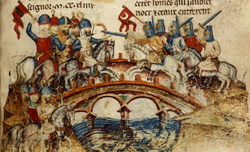
The 1241 Mongol invasion first affected Moldavia and Wallachia (situated east and south of the Carpathians). Tens of thousands of Wallachians and Moldavians lost their lives defending their territories from the Golden Horde. Crops and goods plundered from Wallachian settlements seem to have been a primary supply source for the Golden Horde. The invaders killed up to half of the population and burned down most of their settlements, thus destroying much of the cultural and economic records from that period. Neither the Wallachians nor the army of Hungary offered much resistance against the Mongols.[21] The swiftness of the invasion took many by surprise and forced them to retreat and hide in forests and the enclosed valleys of the Carpathians. In the end, however, the main target of the invasion was the Kingdom of Hungary.[21]
The Hungarian army arrived and encamped at the
During the winter, contrary to the traditional strategy of nomadic armies which started campaigns only in spring-time, they crossed the
The Mongolian invasion taught the Magyars a simple lesson: although the Mongols had destroyed the countryside, the forts and fortified cities had survived. To improve their defense capabilities for the future, they had to build forts, not only on the borders but also inside the country. In the siege of Esztergom, the defenses managed to hold off the Mongolians despite the latter having overwhelming numerical superiority and 30 siege machines which they had just used to reduce the wooden towers of the city.[26][27] During the remaining decades of the 13th century and throughout the 14th century, the kings donated more and more royal land to the magnates with the condition that they build forts and ensure their defenses.
Invasion of Croatia
During the Middle Ages, the
After being routed on the banks of the Sajó river in 1241 by the Mongols, Béla IV fled to today's Zagreb in Croatia. Batu sent a few tumens (roughly 20,000 men at arms) under Khadan in pursuit of Bela. The major objective was not the conquest but the capture of the Arpad king. The poorly fortified Zagreb was unable to resist the invasion and was destroyed, its cathedral burned by Mongols.[31] In preparation for a second invasion, Gradec was granted a royal charter or Golden Bull of 1242 by King Béla IV, after which citizens of Zagreb engaged in building defensive walls and towers around their settlement.[32]
The Mongols' pursuit of Béla IV continued from Zagreb through
Historians estimate that up to half of Hungary's two million population at that time were victims of the Mongol invasion of Europe.[35]
Invasion of Austria
The subjugation of Hungary opened a pathway for the Mongol Horde to invade
Invasion of Bulgaria
During his withdrawal from Hungary back into Ruthenia, part of Batu Khan's army invaded Bulgaria. A Mongolian force was defeated by the Bulgarian army under Tsar
European tactics against Mongols
The traditional European method of warfare of
However, during the initial Mongol invasion and the subsequent raids afterwards, heavily armored knights and cavalry proved more effective at fighting the Mongols than their light-armored counterparts. During the Battle of Mohi, for example, while the Hungarian light cavalry and infantry were decimated by Mongol forces, the heavily armored knights in their employ, such as the Knights Templar, fought significantly better.[47] During the Battle of Liegnitz, the Knights Templar that numbered between 65 and 88 during the battle lost only three knights and 2 sergeants.[48] Austrian knights under Duke Frederick also fared better in fighting the Mongol invasion in Vienna.[39]
King Béla IV of Hungary hired the help of the Knights Hospitaller, as well as training his own better-armed local knights, in preparation for the Second Mongol invasion of Hungary.[49] In the decades following the Mongolian raids on European settlements, Western armies (particularly Hungary) started to adapt to the Mongol tactics by building better fortifications against siege weapons and improving their heavy cavalry.[50] After the division of the Mongol Empire into four fragments, when the Golden Horde attempted the next invasion of Hungary, Hungary had increased their proportion of knights (led by Ladislaus IV of Hungary) and they quickly defeated the main Golden Horde Army in the hills of western Transylvania.[51]
By this time as well, many Eastern and Central European countries had ended their hostilities with one another and united to finally drive out the remnants of the Golden Horde.
Possible Mongol diffusion of gunpowder to Europe
Several sources mention the Mongols deploying firearms and gunpowder weapons against European forces at the Battle of Mohi in various forms, including bombs hurled via catapult.[55][56][57] Professor Kenneth Warren Chase credits the Mongols for introducing gunpowder and its associated weaponry into Europe.[58] A later legend arose in Europe about a mysterious Berthold Schwarz who is credited with the invention of gunpowder by 15th- through 19th-century European literature.[59]
End of the Mongol advance
During 1241, most of the Mongol forces were resting on the Hungarian Plain. In late March 1242, they began to withdraw. The most common reason given for this withdrawal is the Great Khan Ögedei's death on December 11, 1241. Ögedei Khan died at the age of fifty-six after a binge of drinking during a hunting trip, which forced most of the Mongolian army to retreat back to Mongolia so that the princes of the blood could be present for the election of a new great khan. This is attested to by one primary source: the chronicle of Giovanni da Pian del Carpine, who after visiting the Mongol court, stated that the Mongols withdrew for this reason; he further stated that God had caused the Great Khan's death to protect Latin Christendom.[60] As Stephen Pow pointed out in his analysis of this issue, by Carpini's account, a messenger would have to be able to make the journey from Mongolia to Central Europe in a little over three months at a minimum; the messenger would have to arrive in March, meaning he took about three months in the middle of winter from the time of the khan's death. Carpini himself accompanied a Mongol party in a much shorter journey (from Kiev to Mongolia) in 1246, where the party "made great speed" in order to reach the election ceremony in time, and made use of several horses per person while riding nearly all day and night. It took five months.[61]
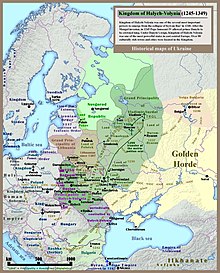
Another theory is that weather data preserved in tree rings points to a series of warm, dry summers in the region until 1242. When temperatures dropped and rainfall increased, the local climate shifted to a wetter and colder environment. That, in turn, caused flooding of the formerly dry grasslands and created a marshy terrain. Those conditions would have been less than ideal for the nomadic Mongol cavalry and their encampments, reducing their mobility and pastureland, curtailing their invasion into Europe west of the Hungarian plain,[64] and hastening their retreat.
The true reasons for the Mongol withdrawal are not fully known, but numerous plausible explanations exist. The Mongol invasion had bogged down into a series of costly and frustrating sieges, where they gained little loot and ran into stiff resistance. They had lost a large number of men despite their victories (see above). Finally, they were stretched thin in the European theater, and were experiencing a rebellion by the Cumans (Batu returned to put it down, and spent roughly a year doing so).[65] Others argue Europe's bad weather had an effect: Hungary has a high water table so it floods easily. An analysis of tree rings there found that Hungary had cold wet weather in early 1242, which likely turned Hungary's central plain into a huge swamp; so, lacking pastures for their horses, the Mongols would have had to fall back to Rus' in search of better grasslands.[66]
Regardless of their reasons, the Mongols had completely withdrawn from Central Europe by mid-1242, though they still launched military operations in the west at this time, most notably the 1241–1243
The historian Jack Weatherford claims that European survival was due to Mongol unwillingness to fight in the more densely populated German principalities, where the weather affected the glue and sinew of the Mongol bows. However, a counter to this assertion is that the Mongols were willing to fight in the densely populated areas of Song China and India. Furthermore, the Mongols were able to conquer Southern China which is located in a tropical climate zone and would have received far more rainfall and humidity than anywhere in Europe.[68][69] The territory of Western Europe had more forests and castles than the Mongols were accustomed, and there were opportunities for the European heavy cavalry to counter-attack[citation needed]. Also, despite the steppe tactics of the Avars and early Hungarians, both were defeated by Western states in the 9th and 10th centuries, though many states conquered by the Mongols have also faced steppe tactics successfully before. A significant number of important castles and towns in Hungary had also resisted the formidable and infamous Mongol siege tactics.
John Keegan thought that Europeans had an advantage due to more food surpluses enabling better campaigns, and larger horses.[70]
Some historians believe that the reason for Batu's stopping at the Mohi River was that he never intended to advance further.[71] He had made the new Rus' conquests secure for the years to come, and when the Great Khan died and Batu rushed back to Mongolia to put in his claim for power, it ended his westward expansion. Subutai's recall at the same time left the Mongol armies without their spiritual head and primary strategist. Batu Khan was not able to resume his plans for conquest to the "Great Sea" (the Atlantic Ocean) until 1255, after the turmoil after Ögedei's death had finally subsided with the election of Möngke Khan as Great Khan. Though he was capable of invading Western Europe, he was no longer interested [citation needed].
Mongol infighting
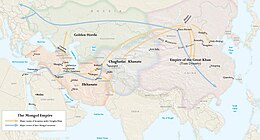
From 1241 to 1248 a state of almost open warfare existed between Batu, son of Jochi, and
Both entities were
Hulagu returned to his lands by 1262, but instead of being able to avenge his defeats, had to turn north to face Berke Khan, suffering severe defeat in an attempted invasion north of the Caucasus in 1263, after Berke Khan had lured him north and away from the Holy Land. Thus, the Kipchak Khanate never invaded Europe, keeping watch to the south and east instead. Berke sent troops into Europe only twice, in two relatively light raids in 1259 and 1265, simply to collect booty he needed to pay for his wars against Hulagu from 1262 to 1265.
Europe at the time of the Mongol invasion

The Papacy had rejected the pleas of Georgia in favor of launching crusades in Iberia and the Middle East, as well as preaching a Crusade against Kievan Rus in 1238 for refusing to join his earlier Balkan Crusade. Meanwhile,
In the 1240s the efforts of Christendom were already divided between five Crusades, only one of which was aimed against the Mongols. Initially, when Bela sent messengers to the Pope to request a Crusade against the Mongols, the Pope tried to convince them to instead join his Crusade against the Holy Roman Emperor. Eventually Pope Gregory IX did promise a Crusade and the Church finally helped sanction a small Crusade against the Mongols in mid-1241, but it was diverted when he died in August 1241. Instead of fighting the Mongols, the resources gathered by the Crusade was used to fight a Crusade against the Hohenstaufen dynasty after the German barons revolted against the Holy Roman Emperor's son Conrad in September 1241.[74]
Later raids
The Golden Horde raids in the 1280s (those in Bulgaria, Hungary, and Poland), were much greater in scale than anything since the 1241–1242 invasion, thanks to the lack of civil war in the Mongol Empire at the time. They have sometimes been collectively referred to as "the second Mongol invasion of Europe", "the second Tatar-Mongol invasion of central and south-eastern Europe",[75] or "the second Mongol invasion of central Europe."[76]
Against Poland (1259 and 1287)
This section relies largely or entirely upon a single source. (March 2023) ) |

In 1259, eighteen years after the first attack, two tumens (20,000 men) from the
An unsuccessful invasion followed in 1287, led by Talabuga and Nogai Khan. 30,000 men (three tumens) in two columns under Nogai (10,000 Mongol cavalry) and Talabuga (20,000 Mongols and Ruthenians) respectively raided Lesser Poland to plunder the area and meet up north of Kraków. Lublin, Mazovia, and Sieradz were successfully raided, but the Mongols failed to capture Sandomierz and Kraków and were repulsed with heavy casualties when they attempted to assault the cities, although the cities were devastated. Talabuga's main army (the rest of his column having dissolved across the countryside for raiding) was defeated by Duke Leszek II at the Battle of Łagów. After this severe setback, Talabuga linked back up with the raiding parties and fled Poland with the loot that was already taken. Nogai's column, after suffering losses during the assault on Kraków, split up to raid the lands both north and south of the city. One detachment headed towards the town of Stary Sącz, another to Podolínec, and others to the Duchy of Sieradz. The first detachment was surprised and defeated by the Poles and their Hungarian allies in the Battle of Stary Sącz, while the second devastated the area of Podhale while skirmishing with the locals. After the defeat at Stary Sącz, Nogai's whole column retreated into Ruthenia.[78]
Against Byzantine Thrace (1265, 1324 and 1337)
During the reign of Berke there was also a raid against
Thrace also suffered raids in 1324 and 1337, during the reign of
Against Bulgaria (1271, 1274, 1280 and 1285)
The successors of Tsar Ivan Asen II – the regency of Kaliman Asen I decided to pay tax to the

Against Hungary (1285)
In 1285 Nogai Khan led a raid of Hungary alongside Talabuga. Nogai lead an army that ravaged Transylvania with success: Cities like Reghin, Brașov and Bistrița were plundered and ravaged. However Talabuga, who led the main army in Northern Hungary, was stopped by the heavy snow of the Carpathians and the invading force was defeated[82] near Pest by the royal army of Ladislaus IV and ambushed by the Székely in the return. Nogai's own column suffered serious casualties. As with later invasions, it was repelled handily, the Mongols losing much of their invading force. The outcome could not have contrasted more sharply with the 1241 invasion, mostly due to the reforms of Béla IV, which included advances in military tactics and, most importantly, the widespread building of stone castles, both responses to the defeat of the Hungarian Kingdom in 1241. The failed Mongol attack on Hungary greatly reduced the Golden Horde's military power and caused them to stop disputing Hungarian borders.[76][83]
Against Serbia (1291)
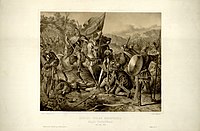
In 1291 a large Mongol-Bulgarian alliance raided into Serbia, where Serbian king
Against Germany (1340)
Contemporary Swiss historian
Counter-invasions of Europe
By the mid-14th century the grip of the Golden Horde over Central and Eastern Europe had started to weaken. Several European kingdoms started various incursions into Mongol-controlled lands with the aim of reclaiming captured territories as well as adding new ones from the Empire itself. The Kingdom of Georgia, under the leadership of King
By this point, some Western European armies also started to meet the Mongols in their conquered territories. In the
Gallery
-
Golden Horde raid at old Ryazan.
-
Golden Horde raid at Kiev
-
Golden Horde raid at Kozelsk
-
Golden Horde raid Vladimir
-
Golden Horde raid Suzdal
-
The Hungarian KingBéla IV on the flight from the Mongols under general Kadan of the Golden Horde.
See also
- Franco-Mongol alliance
- Lists of battles of the Mongol invasion of Europe
- Mongol invasions and conquests
- Mongol military tactics and organization
- Romania in the Early Middle Ages
- Timeline of the Golden Horde
- Timeline of the Mongol Empire
- War of the Heavenly Horses
References
Citations
- ISBN 9780521602709.
- ^
Francis Dvornik (1962). The Slavs in European History and Civilization. Rutgers UP. p. 26. ISBN 9780813507996.
- ^ Michell, Robert; Forbes, Nevell (1914). "The Chronicle of Novgorod 1016–1471". Michell. London, Offices of the society. p. 64. Retrieved June 4, 2014.
- ISBN 9781450729345.
- ^ Bitwa pod Legnicą Chwała Oręża Polskiego Nr 3. Rzeczpospolita and Mówią Wieki. Primary author Rafał Jaworski. 12 August 2006 (in Polish). p. 8
- ^ Bitwa pod Legnicą Chwała Oręża Polskiego Nr 3. Rzeczpospolita and Mówią Wieki. Primary author Rafał Jaworski. 12 August 2006 (in Polish). p. 4
- ^ "Hungary – Culture, History, & People". britannica.com. Archived from the original on May 12, 2008. Retrieved April 28, 2018.
- ^ Hildinger, Erik. Mongol Invasions: Battle of Liegnitz Archived 2008-07-22 at the Wayback Machine. First published as: "The Mongol Invasion of Europe" in Military History, (June, 1997).
- ^ The Destruction of Kiev Archived 2011-04-27 at archive.today
- ISBN 978-1635687118
- ISBN 9780710070739.
- ^ McLynn, Frank. Genghis Khan: his conquest, his empire, his legacy.
- ^ ISBN 978-1860649721
- ISBN 978-1885119438
- ^ Hickman, Kenneth. "Mongol Invasions: Battle of Legnica". ThoughtsCO.com. Archived from the original on April 29, 2017. August 29, 2016
- ISBN 978-1145783386
- ISBN 978-1294890225
- ISBN 978-0521786959
- ^ Długosz, The Annals, 181.
- ^ "Christianity, Europe, and (Utraquist) Bohemia" (PDF). brrp.org. Archived (PDF) from the original on April 28, 2018. Retrieved April 28, 2018.
- ^ a b Epure, Violeta-Anca. "Invazia mongolă în Ungaria şi spaţiul românesc" (PDF). ROCSIR – Revista Româna de Studii Culturale (pe Internet) (in Romanian). Archived (PDF) from the original on October 14, 2015. Retrieved February 5, 2009.
- ^ "Genghis Khan: his conquest, his empire, his legacy"by Frank Lynn
- ^ Michael Prawdin, Gerard (INT) Chaliand The Mongol Empire, p.268
- ISBN 978-0-521-00922-5. Retrieved October 1, 2011.
- ISBN 978-1-4263-0597-9. Retrieved November 28, 2011.
In A.D. 1232 an army of 30,000 Mongol warriors invaded the Chinese city of Kai-fung-fu, where the Chinese fought back with fire arrows...Mongol leaders learned from their enemies and found ways to make fire arrows even more deadly as their invasion spread toward Europe. On Christmas Day 1241 Mongol troops used fire arrows to capture the city of Buda in Hungary, and in 1258 to capture the city of Baghdad in what's now Iraq.
- ^ Stephen Pow, Lindsay – Deep Ditches and Well-built walls. pp. 72, 132
- ^ a b Z. J. Kosztolnyik -- Hungary in the 13th Century, East European Monographs, 1996. p. 174
- ^ "Croatia (History)". Encarta. Archived from the original on October 31, 2009.
- ^ Ltd., ICB - InterConsult Bulgaria. "CEEOL - Obsolete Link". www.ceeol.com. Archived from the original on August 1, 2017. Retrieved April 28, 2018.
- ^ "Croatia (History)". Encyclopædia Britannica. Archived from the original on August 14, 2014.
- ^ 750th Anniversary of the Golden Bull Granted by Bela IV Archived April 28, 2005, at the Wayback Machine
- ^ a b Klaić V., Povijest Hrvata, Knjiga Prva, Druga, Treća, Četvrta i Peta Zagreb 1982(in Croatian)
- ^ Thomas of Split, Historia Salonitana.
- ^ "Klis – A gateway to Dalmatia" (PDF). Archived from the original (PDF) on July 18, 2011.
- ^ "Hungary - History". Encyclopedia Britannica. Retrieved February 18, 2023.
The country lost about half its population, the incidence ranging from 60 percent in the Alföld (100 percent in parts of it) to 20 percent in Transdanubia; only parts of Transylvania and the northwest came off fairly lightly.
- ^ "Map Walk 20132013: The Conquests of the Mongols". Cleveland History. Archived from the original on March 9, 2017.
- ISBN 9780710070739.
- ISBN 978-0582368965
- ^ ISBN 978-1605201337
- ^ Giessauf, Johannes (1997). "Herzog Friedrich II von Österreich und die Mongolengefahr 1241/42" (PDF). In H. Ebner; W. Roth (eds.). Forschungen zur Geschichte des Alpen-Adria-Raumes. Graz. pp. 173–199 [1–30].
{{cite book}}: CS1 maint: location missing publisher (link)[permanent dead link] - ^ Howorth, Sir Henry Hoyle. History of the Mongols: From the 9th to the 19th Century, Volume 1. Forgotten Books (June 15, 2012). p. 152. ASIN B008HHQ8ZY
- ISBN 954-427-216-X.pp. 192–193
- ^ Peter Jackson. The Mongols and the West: 1221–1410. 2005. p.65
- ^ Jackson, p.79
- ^ Jackson, p.105
- ISBN 978-0-85229-961-6.
- ^ Peter F. Sugar, Péter Hanák, Tibor Frank – A History of Hungary. p.27: "The majority of the Hungarian forces consisted of light cavalry, who appeared 'foreign' to the Western observers. Yet this army had given up nomadic battle tactics and proved useless when facing the masters of this style of warfare. Hungarian tactics were a mix of eastern and western military traditions, as were the ineffective walls of clay bricks and palisades. Two elements of the Hungarian defense had proved effective, however: close combat with mass armored knights and stone fortifications".
- ISBN 0-582-36896-0.
- ^ Peter F. Sugar, Péter Hanák, Tibor Frank – A History of Hungary pp. 28–29
- ^ Stephen Pow, Lindsay – Deep Ditches and Well-built walls pp. 59, 76
- ^ Z. J. Kosztolnyik – Hungary in the 13th Century, East European Monographs, 1996, p. 286
- ^ Peter Jackson. The Mongols and the West: 1221–1410. 2005. p.205
- ^ Anchalabze, George. The Vainakhs. Page 24
- ^ Klaić V., Povijest Hrvata, Knjiga Prva, Druga, Treća, Četvrta i Peta Zagreb 1982. (Croatian)
- ISBN 978-1-57143-155-4. Retrieved July 29, 2011.
- ISBN 978-0-226-56141-7. Retrieved July 29, 2011.
- ISBN 978-0-440-50553-2. Retrieved July 29, 2011.
- ISBN 978-0-521-82274-9. Retrieved July 29, 2011.
- ^ Kelly (2005), p.23
- ^ John of Plano Carpini, "History of the Mongols," in The Mission to Asia, ed. Christopher Dawson (London: Sheed and Ward, 1955), 44
- ^ Carpini, History of the Mongols, 60; Pow, Deep ditches and well-built walls, pp. 19-21
- ^ Rashid al-Din, Successors, 70–71.
- ^ Rashid al-Din, Successors, 10–11. Translated by John Andrew Boyle. Boyle's preamble notes: "There are not infrequent interpolations from the Mongolian chronicle, and he even adopts its faulty chronology, in accordance with which the events of the European campaign take place a year later than in reality. In the present volume, Juvaini is down to the reign of Mongke (1251–1259) Rashid al-Din's main authority, but with considerable additional material from other sources. Thus the earlier historian's account of the invasion of eastern Europe (1241–1242) is repeated almost verbatim and is then followed, in a later chapter, by a much more detailed version of the same events, based, like the preceding description of the campaigns in Russia (1237–1240), on Mongol records, as is evident from the orthography of the proper names."
- ^ "Climate probably stopped Mongols cold in Hungary, Science News, Science Ticker: Climate, Anthropology". By Helen Thompson. 2016. Archived from the original on August 3, 2016. Retrieved May 26, 2016.
- ^ Rashid al-Din, Successors, 71–72.
- PMID 27228400.
- ^ J. J. Saunders, The History of the Mongol Conquests (London: Routledge & Kegan Paul, 1971), 79.
- ^ Climate
- ^ Rain#Wettest known locations
- ^ Sir John Keegan (1987) The Mask of Command, Viking: London, page 118
- ^ "The Mongols in the West, Journal of Asian History v.33. n.1". By Denis Sinor. 1999. Archived from the original on September 1, 2009. Retrieved August 16, 2009.
- ^ Amitai-Preiss, Reuven. The Mamluk-Ilkhanid War
- ^ Frank McLynn, Genghis Khan (2015); Chris Peers, the Mongol War Machine (2015); Timothy May, the Mongol Art of War (2016). pp. 448–51
- ^ Frank McLynn, Genghis Khan (2015); Chris Peers, the Mongol War Machine (2015); Timothy May, the Mongol Art of War (2016). pp. 450–1.
- ^ Peter Jackson, "The Mongols and the West", 2005. Page 199
- ^ a b Victor Spinei. "Moldavia in the 11th–14th centuries." Editura Academiei Republicii Socialiste România. Bucharest, 1986. Pages 121–122.
- ^ Stanisław Krakowski, Polska w walce z najazdami tatarskimi w XIII wieku, MON, 1956, pp. 181–201
- ^ Stanisław Krakowski, Polska w walce z najazdami tatarskimi w XIII wieku, MON, 1956.
- ^ René Grousset The Empire of Steppes, page 399–400
- ^ Denis Sinor, "The Mongols in the West." Journal of Asian History (1999) pp: 1–44.
- ISBN 954-427-216-X.pp. 222
- ^ Pál Engel, Tamás Pálosfalvi, Andrew Ayton: The Realm of St. Stephen: A History of Medieval Hungary, 895-1526, I.B.Tauris & Co Ltd, London, pp. 109 [1]
- ^ The Roots of Balkanization: Eastern Europe C.E. 500–1500 – By Ion Grumeza Google Books.
- ^ István Vásáry Cumans and Tatars: Oriental military in the pre-Ottoman Balkans, 1185–1365, p.89
- ^ Jackson, Peter (2005). The Mongols and the West, 1221–1410. Routledge. pp. 206, 227.
- ^ D. Kldiashvili, History of the Georgian Heraldry, Parlamentis utskebani, 1997, p. 35.
- ^ Cherkas, Borys (December 30, 2011). Битва на Синіх Водах. Як Україна звільнилася від Золотої Орди [Battle at Blue Waters. How Ukraine freed itself from the Golden Horde] (in Ukrainian). istpravda.com.ua. Archived from the original on March 4, 2016. Retrieved February 22, 2016.
- ISBN 0-295-97290-4.
- ^ Kortüm, Hans-Henning. Transcultural Wars: from the Middle Ages to the 21st Century Akademie Verlag (March 22, 2006). p. 227
- PMID 12194776.
Sources
- Sverdrup, Carl (2010). "Numbers in Mongol Warfare". Journal of Medieval Military History. Boydell Press. 8: 109–17 [p. 115]. ISBN 978-1-84383-596-7.
Further reading
- Allsen, Thomas T. (March 25, 2004). Culture and Conquest in Mongol Eurasia. Cambridge UP. ISBN 9780521602709.
- Atwood, Christopher P. Encyclopedia of Mongolia and the Mongol Empire (2004)
- Chambers, James. The Devil's Horsemen: The Mongol Invasion of Europe (London: Weidenfeld and Nicolson, 1979)
- Christian, David. A History of Russia, Central Asia and Mongolia Vol. 1: Inner Eurasia from Prehistory to the Mongol Empire (Blackwell, 1998)
- Cook, David, "Apocalyptic Incidents during the Mongol Invasions", in Brandes, Wolfram / Schmieder, Felicitas (hg), Endzeiten. Eschatologie in den monotheistischen Weltreligionen (Berlin, de Gruyter, 2008) (Millennium-Studien / Millennium Studies / Studien zu Kultur und Geschichte des ersten Jahrtausends n. Chr. / Studies in the Culture and History of the First Millennium C.E., 16), 293–312.
- Halperin, Charles J. Russia and the golden horde: the Mongol impact on medieval Russian history (Indiana University Press, 1985)
- May, Timothy. The Mongol conquests in world history (Reaktion Books, 2013)
- Morgan, David. The Mongols, ISBN 0-631-17563-6
- Nicolle, David. The Mongol Warlords, Brockhampton Press, 1998
- Reagan, Geoffry. The Guinness Book of Decisive Battles, Canopy Books, New York (1992)
- Saunders, J.J. The History of the Mongol Conquests, Routledge & Kegan Paul Ltd, 1971, ISBN 0-8122-1766-7
- Sinor, Denis (1999). "The Mongols in the West". Journal of Asian History. 33 (1). Archived from the original on June 5, 2011. Retrieved April 21, 2007.; also in JSTOR
- Vernadsky, George. The Mongols and Russia (Yale University Press, 1953)
- Halperin, Charles J. "George Vernadsky, Eurasianism, the Mongols, and Russia." Slavic Review (1982): 477–493. in JSTOR
- Craughwell, Thomas J. (February 1, 2010). The Rise and Fall of the Second Largest Empire in History: How Genghis Khan almost conquered the world. Fair Winds. ISBN 9781616738518.
- Kauffman, JE (April 14, 2004). The medieval Fortress:Castles, Forts and Walled Cities of the medieval ages. Da Capo Press. ISBN 978-0-306-81358-0.\
- Fagan, Brian (August 1, 2010). The Great Warming:Climate Change and the Rise and Fall of Civilization. Bloomsbury Press. ISBN 978-1-59691-780-4.
- Penn, Imma (2007). Dogma Evolution & Papal Fallacies:An Unveiled History of Catholicism. AuthorHouse. ISBN 978-1-4343-0874-0.

